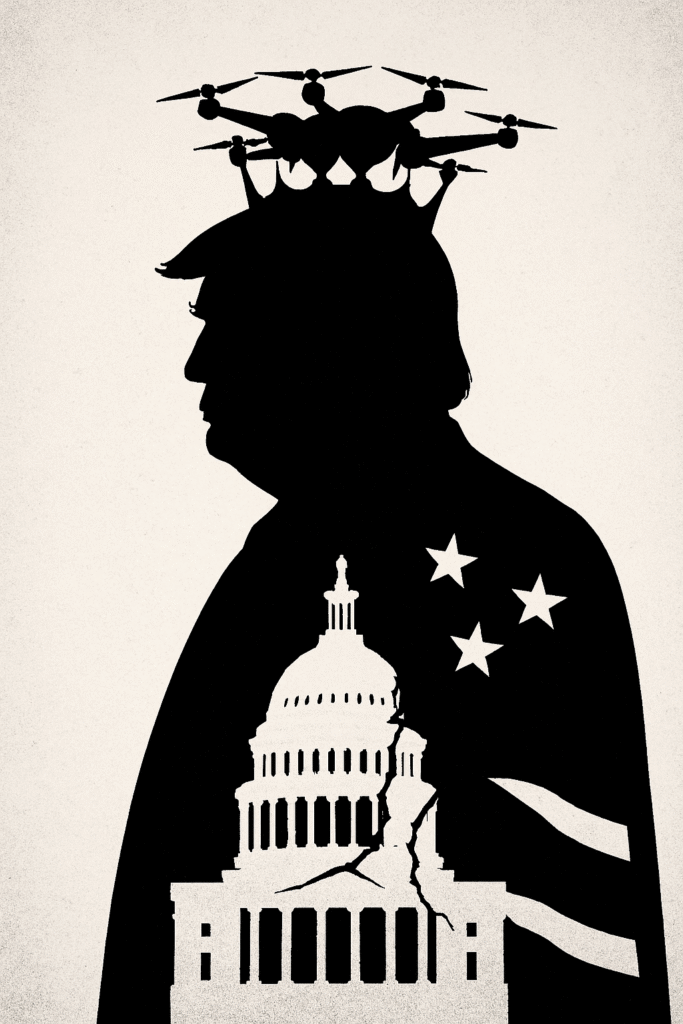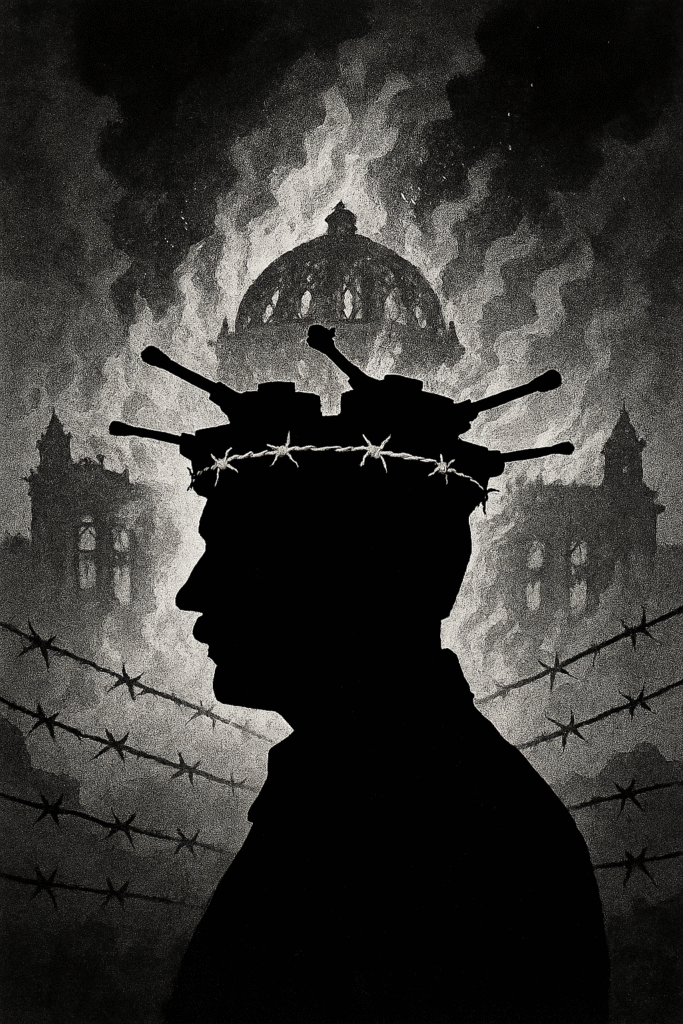By now, many scholars, journalists, and civil liberties experts have drawn comparisons between Donald Trump’s rise to power and authoritarian behavior with Adolf Hitler’s early political strategies. While the historical contexts and outcomes may as of yet be different, several specific parallels have been identified. Here’s a structured look at the most commonly cited similarities:
Comparative Themes of Dictatorial Behavior
1. Populist Outsider Appeal
- Hitler: Rose from obscurity by positioning himself as the savior of a broken Germany, building the Nazi Party from the ground up.
- Trump: Entered politics as a wealthy celebrity outsider, taking over the Republican Party and claiming only he could “fix” America.
2. Media Mastery & Spectacle
- Hitler: Used radio, film, and mass rallies to energize followers and intimidate opponents.
- Trump: Leveraged TV (e.g., The Apprentice) and social media (Twitter and Truth Social) to dominate public discourse and build a loyal base.
3. Authoritarian Leadership Style (Führerprinzip)
- Hitler: Advocated for a single, infallible leader whose will overrides law and institutions.
- Trump: Has shown similar tendencies—issuing sweeping executive orders (As of August 2025, Donald Trump has signed a total of 411 executive orders across both of his presidencies: 220 executive orders during his first term (2017–2021) and 191 executive orders so far in his second term (2025), demanding loyalty, and suggesting parts of the Constitution be suspended.
4. Rhetoric of Division and “Othering”
- Hitler: Blamed Jews, Communists, and others for Germany’s problems.
- Trump: Targeted immigrants, Muslims, and political opponents, often using inflammatory language that echoes exclusionary nationalism.
5. Disregard for Democratic Norms
- Hitler: Used legal mechanisms to dismantle democracy after gaining power.
- Trump: Repeatedly questioned election legitimacy, encouraged Capitol rioters, and suggested suspending constitutional norms. Ordered the Texas House to redraw political maps which have been proven to be not only politically divisive, but also racially discriminatory, violating Federal law (see the Voting Rights Act of 1965).
6. Use of Paramilitary or Militia Support
- Hitler: Relied on stormtroopers (SA) to enforce party dominance.
- Trump: Expressed support for groups like the Proud Boys and minimized the threat posed by the January 6 insurrection. he also has the government agency I.C.E (Immigrations and Customs Enforcement) acting as a sort of personal police force.
Political Trajectories Compared
This is a detailed side-by-side comparison of Donald Trump (as of August, 2025), and Adolf Hitler’s political trajectories, media strategies, and institutional impacts. This isn’t about equating outcomes—Hitler’s regime led to genocide and global war—but about identifying patterns of authoritarian behavior and tactics of power consolidation.
| Category | Adolf Hitler | Donald Trump |
| Origins | WWI veteran, failed artist, joined fringe nationalist party (DAP) | Dodged draft, wealthy businessman, reality TV star, no prior political office before 2016 |
| Party Takeover | Transformed DAP into Nazi Party (NSDAP), became Führer | Took over Republican Party, reshaped it around his persona |
| Rise to Power | Legally appointed Chancellor in 1933, then consolidated power | Elected President in 2016, later dominated GOP and reshaped norms, re-elected 2024 |
| Use of Crisis | Exploited economic depression, Treaty of Versailles resentment | Leveraged economic anxiety, immigration fears, and anti-elite sentiment, claim of rampant crime in Democratic cities. |
| Legitimacy Strategy | Claimed to restore German pride and purity | Claimed to “Make America Great Again,” positioned as anti-establishment savior |
Media Strategy and Propoganda
| Tactic | Adolf Hitler | Donald Trump |
| Mass Spectacle | Rallies, radio broadcasts, films like Triumph of the Will | Rallies, Twitter dominance, reality TV persona |
| Image Softening | Orchestrated “Hitler at Home” lifestyle stories to humanize him | Podcast appearances, family-focused interviews, pop culture engagement |
| Control of Narrative | Censorship, state-run media, Joseph Goebbels’ propaganda machine | Attacks on the press, lawsuits against the media, legal harassment of political adversaries, and curated press access |
| Targeted Messaging | Anti-Semitic, anti-Communist, racial purity themes | Anti-immigrant, anti-Muslim, “deep state” conspiracies, QAnon pandering |
| Audience of One | Propaganda tailored to Hitler’s preferences | Lobbyists run ads in Trump’s media markets to influence him directly, acceptance of personal gifts from terrorist nations, and personal profiteering from office of the President (in violation of the Constitutional Emoluments Clauses) |
Institutional Impact
| Domain | Adolf Hitler | Donald Trump |
| Democratic Norms | Dismantled Weimar democracy via Enabling Act | Undermined norms: refused transparency, attacked election legitimacy, and violated the Posse Comitatus Act |
| Judiciary & Law | Politicized courts, eliminated opposition | Pressured DOJ, politicized FBI, resisted investigations, and court orders |
| Civil Service | Purged and replaced officials with loyalists | Loyalty tests, firings via tweet, reshaped the entire Federal bureaucracy |
| Party Transformation | Nazi Party became totalitarian instrument | GOP became “Party of Trump,” sidelining moderates |
| Use of Violence | SA and SS enforced control, terrorized opponents | Encouraged the Capitol riot, minimized militia threats grants ICE agents anonymity |
Legal Mechanisms to Expand Power
Hitler’s Tools
- Reichstag Fire Decree (1933): Suspended civil liberties, enabled mass arrests
- Enabling Act (1933): Allowed Hitler to pass laws without Reichstag approval
- Night of the Long Knives (1934): Used emergency powers to purge rivals
- Merger of Offices (1934): Combined presidency and chancellorship to become Führer
Trump’s Tools
- IEEPA Tariffs: Used emergency powers to impose sweeping tariffs; now under legal challenge
- Executive Orders: Over 120 signed in first four months of 2025 alone, bypassing Congress
- Federalization Threats: Takes control of D.C. government and police
- Constitutional Convention Push: Allies pushing for amendments to expand executive power
- Mass Deportation via Military: Invoked Alien Enemies Act, used Guantanamo for detainees
Ending Thoughts Regarding Comparison of Hitler and Trump Rise to Power
While Trump’s actions have not yet culminated in genocide (aside from his military support for Netanyahu’s genocide and displacement of Palestinians) or global war (although both east and west are threatening that nuclear conflagration is on the table), the methods of power acquisition and consolidation—especially the use of media, populist rhetoric, and institutional erosion—show disturbing parallels to Hitler’s early years. The lesson isn’t that history repeats precisely, but that authoritarian tendencies often follow recognizable patterns.


Post Script:
In a 1990 Vanity Fair profile written by Marie Brenner, Ivana Trump—Donald Trump’s first wife—was interviewed and had reportedly told her lawyer, Michael Kennedy, that her husband would occasionally read from a book of Adolf Hitler’s collected speeches titled My New Order, which he kept in a cabinet by his bed.
When journalist Marie Brenner asked Donald Trump whether his cousin John Walter had given him a book of Hitler’s speeches, Trump hesitated and replied:
“Who told you that?”
Then Trump confessed, “It was my friend Marty Davis from Paramount who gave me a copy of Mein Kampf, and he’s a Jew.”
However, Davis later clarified:
“I did give him a book about Hitler. But it was My New Order, Hitler’s speeches, not Mein Kampf. I thought he would find it interesting. I am his friend, but I’m not Jewish.”

Comments
Very interesting, and hard to ignore the parallels. Someone once said, “History repeats, first time as tragedy, second time as farce.” That would explain the current situation.
Question: How do you reconcile the belief that some Baha’is have that they should avoid all discussion of politics?
As for myself, I do try to remain neutral when it comes to politics. I am certainly non-partisan. I see the good, as well as the corruption of both political parties in the US, which I’ve coined the “Demorepublicratican” party. This is because to me they have very similar foreign policies, while appearing to have differing domestic policies.
I submitted this article not because I am anti-republican (I am not), but because I am pro-humanity. And a large part of the purpose of the Close of the Age blog is to help people who are waking up to do so with haste.